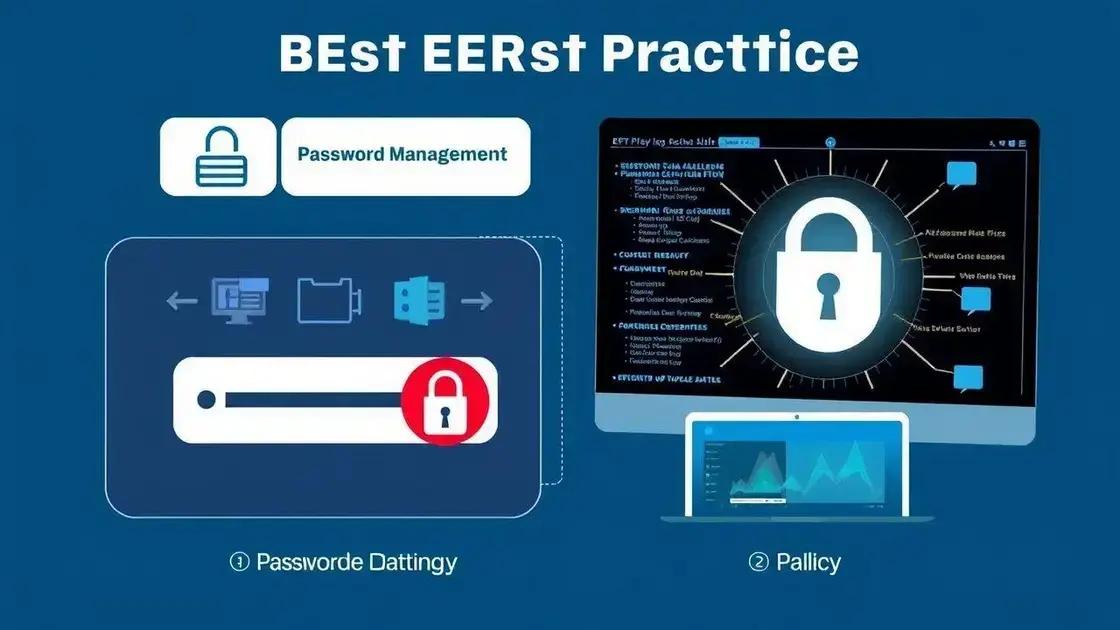Cybersecurity threats in business: are you prepared?

Anúncios
Cybersecurity threats in business include phishing, malware, and ransomware, leading to financial losses and reputational damage; adopting best practices and emerging technologies is essential for effective protection.
Cybersecurity threats in business are an ever-growing concern that can impact any organization. Have you wondered how secure your company really is? In this article, we’ll dive into common threats and protective measures.
Anúncios
Types of cybersecurity threats every business faces
Understanding the types of cybersecurity threats every business faces is essential for any organization. Cyber threats can vary widely, from simple attacks to complex schemes that can endanger sensitive data and operations.
Common Cybersecurity Threats
There are several notable threats that businesses should be aware of to protect themselves effectively.
Anúncios
- Phishing Attacks: Fraudulent emails that trick employees into revealing sensitive information.
- Malware: Malicious software designed to disrupt, damage, or gain unauthorized access to a computer system.
- Ransomware: A type of malware that locks files and demands payment for access.
- DDoS Attacks: Distributed Denial of Service attacks aimed at overwhelming a company’s systems, causing downtime.
Each of these threats poses a significant risk. Phishing attacks are often the gateway for more severe breaches, while ransomware can halt business operations in a heartbeat. Malware is constantly evolving, making it crucial for businesses to stay updated on the latest security measures.
Emerging Threats
Businesses also need to be vigilant about new threats as the cyber landscape continues to evolve. For example, IoT devices are often less secure, offering hackers a gateway into corporate networks. As our reliance on technology grows, so does the sophistication of cybercriminals.
Staying informed about potential risks is not just advisable—it’s necessary. By implementing robust cybersecurity measures and training staff on recognizing potential threats, businesses can significantly reduce their vulnerability. Adopting a proactive approach to cybersecurity enables companies to respond swiftly to any incident, minimizing damage and protecting valuable data.
Identifying vulnerabilities in your organization
Identifying vulnerabilities in your organization is a crucial step in strengthening cybersecurity. Every business has some weaknesses that could be exploited by cybercriminals. Understanding these vulnerabilities allows you to implement proper safeguards.
Assessing Your Systems
Start by evaluating your current systems and processes. Look for outdated software, insufficient security protocols, and untrained employees. Managing these issues proactively is essential. Regular audits help in identifying potential weak spots.
- Software Updates: Ensure all software is up to date to protect against known security flaws.
- Employee Training: Regularly train employees in cybersecurity best practices to reduce human error.
- Access Controls: Limit access to sensitive information to only those who absolutely need it.
- Network Security: Use firewalls and intrusion detection systems to monitor network traffic.
Beyond technological assessments, remember to consider physical security as well. This includes protecting your facilities from unauthorized access and securing devices that contain sensitive information. A comprehensive approach should cover both the digital and physical fronts.
The Importance of Regular Testing
Conduct regular penetration tests to simulate real-world attacks. This proactive approach can uncover hidden vulnerabilities before they can be exploited. Also, consider employee involvement in these tests, as they often serve as the first line of defense. Engage your team in discussions about threat awareness and incident response plans.
By actively identifying vulnerabilities, your organization can take necessary actions before threats materialize. Implementing a culture of security awareness ensures that everyone in the organization contributes to a safer environment. When vulnerabilities are recognized and addressed, the chances of a successful attack can decrease significantly.
Best practices for safeguarding your data

Implementing the best practices for safeguarding your data is essential for any business. Data breaches can lead to significant financial losses and damage to your company’s reputation. By recognizing effective strategies, you can significantly reduce risks.
Develop Strong Password Policies
Start with password management. A strong password policy is vital for preventing unauthorized access. Encourage the use of long, complex passwords. Consider implementing two-factor authentication to add an additional security layer.
- Use Password Managers: These tools help create and store strong passwords securely.
- Regularly Update Passwords: Employees should change passwords periodically to maintain security.
- Avoid Password Sharing: Educate employees on the risks of sharing passwords both inside and outside the organization.
When it comes to storing data, ensure that you are using encrypted solutions which protect sensitive information. This makes it much harder for unauthorized individuals to access your data, even if they gain entry to your systems.
Regular Backups and Updates
Regularly back up your data to safeguard against loss. Use both cloud storage and physical drives to create copies of your important information. Regular updates come next; keep software updated to protect against vulnerabilities.
It is also important to monitor your systems continuously. Implement strong monitoring tools to detect unusual activities. If something seems off, having alert systems in place ensures that you can respond quickly to potential issues.
By following these best practices, organizations can secure their data effectively. Investing in cybersecurity not only protects valuable assets but also builds trust with clients, showing them that their information is safe and secure.
Consequences of ignoring cybersecurity risks
Ignoring cybersecurity risks can lead to severe consequences for any organization. The impact of a security breach goes far beyond immediate financial losses. It can affect a company’s reputation, customer trust, and overall business sustainability.
Financial Losses
One of the most immediate consequences is financial loss. Cyber attacks can lead to costly data recovery processes, legal fees, and potential fines from regulatory bodies. Often, businesses must pay for upgraded security measures post-breach, which can strain budgets significantly.
- Data Breach Costs: The expenses incurred from responding to data breaches can average in the millions.
- Lawyer Fees: Legal repercussions from lawsuits can quickly mount for companies that suffer breaches.
- Reputation Repair: Investing in public relations to restore reputation takes time and resources.
These financial setbacks can jeopardize small businesses, hindering growth and sustainability. However, the impact extends beyond just finances.
Damage to Reputation
When customers hear about security breaches, their trust in a company can diminish. A tarnished reputation can lead to lost sales and a decline in customer loyalty. Word of mouth and online reviews can significantly influence new customers. A single incident could deter potential clients and drive existing ones to competitors.
Furthermore, regulatory repercussions can add to the burden. Organizations face increased scrutiny and may need to adhere to stricter compliance rules. Failing to address cybersecurity risks not only results in reactive consequences but also leads to proactive requirements that can be resource-intensive.
Ultimately, ignoring cybersecurity actually increases the likelihood of further attacks. When businesses neglect security measures, they communicate a lack of vigilance, making them attractive targets for cybercriminals. It is essential for organizations to take cybersecurity risks seriously and develop robust strategies to mitigate them.
Future trends in business cybersecurity
The future trends in business cybersecurity indicate a rapidly changing landscape shaped by emerging technologies and increasing threats. As cybercriminals become more sophisticated, businesses must adapt to protect their valuable assets.
Artificial Intelligence and Machine Learning
One area seeing growth is the use of artificial intelligence (AI) and machine learning (ML). These technologies can analyze vast amounts of data to detect unusual patterns and identify potential threats in real time.
- Automated Threat Detection: AI enables quicker identification of threats that human analysts might miss.
- Predictive Analysis: ML algorithms can predict future attacks based on historical data, allowing businesses to be proactive.
- Behavioral Analysis: AI can learn normal user behaviors to identify anomalies, enhancing security responses.
As these technologies become more widespread, companies must invest in training employees to understand and utilize them effectively.
Zero Trust Security Models
Another trend is the adoption of Zero Trust security models. This approach assumes that threats can exist both outside and inside the network, therefore, strict verification is required for every user attempting to access resources.
In a Zero Trust model, no one is trusted by default. Implementing this requires investing in multiple layers of security, such as multi-factor authentication and continuous monitoring of user activities.
Moreover, the rise of remote work has made cloud security paramount. As employees access systems from various locations, securing data in the cloud has become increasingly crucial.
Regulatory Changes and Compliance
As cybersecurity threats grow, so do regulations and compliance requirements. Businesses need to stay updated on laws governing data protection to avoid fines and legal consequences.
Staying ahead of these trends is essential for any business aiming to protect its operations and customer data. By embracing advanced technologies and adopting modern security practices, organizations can create a robust defense against cyber threats.
FAQ – Frequently Asked Questions About Cybersecurity in Business
What are the common types of cybersecurity threats for businesses?
Common threats include phishing attacks, malware, ransomware, and DDoS attacks, each posing unique risks.
How can businesses protect themselves from these threats?
Businesses can implement strong password policies, conduct regular training, use firewalls, and ensure software updates.
What is a Zero Trust security model?
A Zero Trust model means assuming that threats exist both outside and inside the network, requiring strict verification for all users.
Why is it important to keep up with cybersecurity trends?
Staying updated helps businesses adapt to new threats and technologies, ensuring better protection and compliance.






